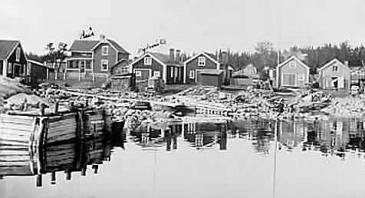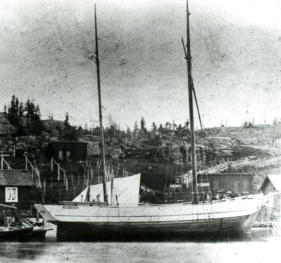

Copyright © Hans Högman 2022-04-02
Gamla jakt- och
fångstmetoder (3)
English
History of Old Hunting and
Trapping Methods - Sweden
Introduction
Hunting involves searching for, tracking, pursuing,
capturing, and killing game. Originally, hunting was
used to obtain food, clothing, and footwear. The
hunting methods used varied greatly depending on
the terrain, prey, and technological factors.
The title picture above shows "Wolf hunting in
Westergötland" by Fritz von Dardel in 1847. A sled
with three men and a pig is pursued by two wolves.
Image: Wikipedia.
Fishing is the catching of animals in the water, such as
fish, shellfish, etc., either professionally or as
recreational fishing (i.e. either subsistence fishing with
professional gear or sport fishing). A person who
engages in fishing on a professional basis is called a
fisherman.
Related Links
•
Old hunting and trapping methods, page 1
•
Old hunting and trapping methods, page 2
•
The Old Agricultural Society and its People
•
The conceptions of croft (torp) and crofters
(torpare)
•
The Concept of Nobility
•
Summer Pasture - Fäbodar
•
The subdivisions of Sweden into Lands, Provinces
and Counties
•
Map, Swedish provinces
•
Map, Swedish counties
Source References
•
Det gamla Ytterlännäs, Sten Berglund, 1974.
Published by Ytterlännäs Hembygdsförening.
Chapter 41 (page 395).
•
Jaktens historia i Sverige : vilt - människa -
samhälle - kultur, Kjell Danell; Roger Bergström;
Leif Mattsson; Sverker Sörlin. 2016.
•
Vilt i Sverige och Europa – igår, idag och imorgon,
Daniel Ligné, Svenska Jägarförbundet
•
Is the fear of Wolves justified? A Fennoscandian
perspective, 2002. John D.C. Linnell, Erling J.
Solberg, Scott Brainerd, Olof Liberg, Håkan Sand,
Petter Wabakken, Ilpo Kojola.
•
Makten över jakten, article in Populär Historia by
Gunnar Brusewitz 2001.
•
Om fiskfångst med snara. Edvard Wibeck. 1915.
•
Fisket i stockholms skärgård under historisk tid.
Havsmiljöinstitutets rapport nr 2021:3. Henrik
Svedäng och Carl Rolff.
•
Björn i Nordisk familjebok (andra upplagan, 1905)
•
Nordisk familjebok / Uggleupplagan. 12.
Hyperemi - Johan / 1203-1204
•
Wikipedia
•
Swedish church books
Top of page

Fishing Rights in former Days
Already in the Middle Ages, fishing on the coast and in
the rivers was considered to belong to the Crown or
the King, water regalia. In the 16th century, King Gustav
Vasa extended the Crown's right to include lake
fishing, the tax revenue from which went to the Crown.
In other words, it was not only the productive salmon
fishing in the rivers that were taxed but also the
fishing in the lakes. Preserved tax documents from the
time of Gustav Vasa and his sons bear witness to this.
Baltic Herring Fishing along the Coast of
Norrland - The Gävle fishermen
Gustav Vasa thus strengthened the Crown's legal claim
- called the King's rightful commons - and extended
the tax obligation also to the Baltic herring fishing in
Norrland, which had previously not been a taxable
commons and available to all and sundry. In 1557,
Gustav Vasa granted a royal privilege to fishing citizens
from the City of Gävle, who now had the exclusive
right to Baltic herring fishing along the coast of
Norrland in return for paying every tenth barrel of
fish to the Crown. Gävle was then the only city (with
town rights) in Norrland.
This exclusive right was loosened up somewhat by
subsequent rulers in the latter part of the 16th and
17th centuries, so that fishing citizens from towns on
Lake Mälaren, such as Enköping, Torshälla, Strängnäs,
and Västerås, were also allowed to fish along the coast
of northern Sweden. But in time these more southerly
fishermen abandoned the area and the Gävle citizens
were left alone.
Gävle fishermen established fishing villages (Swe:
fiskelägen) from Gävle all the way up to northern
Ångermanland. These fishing villages came to be
known as Gävle fishermen’s ports. When new towns
were founded along the Norrland coast, the situation
became more complicated. After Hudiksvall and
Härnösand were granted city rights in the 1580s, their
burghers tried to take over Gävle's fishing villages.
After two more towns were added in the 1620s,
Söderhamn, and Sundsvall, the burghers there also
tried to take over nearby fishing grounds.
On Brämö Island south of Sundsvall in Njurunda
parish, there are two communities, Sanna on the
mainland side of the island where the pilot station was
located, and Norrhamn on the northern side of the
island. Norrhamn consists of the old fishing villages
Hamn and Viken. Norrhamn became a fishing village
for the Gävle fishermen. In Norrhamn is the Brämö
chapel from the early 17th century, and to the east is
the Brämö lighthouse, which was built in 1859. The
oldest of the current fishing cottages date from the
early 18th century.
The image shows the fishing village Norrhamn on
Brämö Island, Njurunda parish, south of Sundsvall,
around 1910 - 1914. Image: Sundsvall museum, ID:
SuM-foto019118.
In 1623, the citizens of Sundsvall wrote to the
Councillor of the Realm Johan Skytte, stating that the
new town needed additional privileges, especially
fishing grounds, to develop. The town was then
allowed to take over the Gävle fishermen’s old fishing
grounds of Lörudden and Brämön in Njurunda parish
and Rödviken in Tynderö parish. The Gävle fishermen
remained, but from then on as tenants.
As Sundsvall grew, however, the demand for fishing
grounds from the citizens increased, and in 1701 the
city simply decided to turn the Gävle inhabitants away.
As a result, some of the Gävle fishermen became
residents of the area. Soon the old long-distance
fishing in Medelpad province was a thing of the past,
while several fishing villages were established around
the city of Gävle.
In Härnösand in 1652, the mayors decreed that "no
stranger" would henceforth be allowed to fish closer
than 20 km from the town. This meant that the Gävle
fishermen had to leave Storön and Hemsön. In 1707,
the Gävle fishermen agreed with the citizens of
Härnösand that they would jointly use the fishing
grounds, except those located less than 20 km from
the town.
In 1766, the Crown's water regalia was abolished by
a new fishing charter, which meant that anyone who
owned a coastal strip also had the right to fish. This led
to the final abolition of the Gävle fishing privileges in
1773. The burghers of Härnösand and Sundsvall
bought the fishing rights.
From around 1740, the Gävle fishermen were
organized in a so-called society (guild), known as the
“fiskarsocieteten”, i.e. the fishermen's society.
The town fishermen of Gävle sailed north in May. At
the beginning of the 18th century, they mainly used
covered yachts and uncovered or half-covered ketches
known as “haxar” (haxe in the singular), but also a
type of boat that was known as “skötbåtar”.
In the middle of the 18th century, the members of the
Gävle Fishermen's Society (guild) had about 60 “haxar”.
These freighters were used to transport the families of
the town fishermen to the fishing grounds, where sons
and farmhands were left to do the fishing. The father
of the house himself would then leave the port to sail
along the coast to do freight service, sometimes as far
as Pomerania or Danzig. In September or October, the
family would be picked up again. The ships carried all
kinds of small pets such as chickens, goats, pigs, and
ducks, as well as the food needed for the stay at the
fishing grounds. Throughout the summer, fish was
preserved in the form of salted Baltic herring,
fermented Baltic herring (Swe: surströmming), and
“krampsill” (sun-dried herring). In the autumn, this was
transported back to Gävle for sale. In 1742, 6,500
barrels of salted herring were taken home, and in
1816 no less than 10,000 barrels.
A "haxe" is a small, flat-bottomed coastal working
vessel (ketch), rigged as a galleass, used in the 18th
and 19th centuries. The name “haxe” comes from
“haaksi” in Finnish, an archaic word for a small cargo
boat, or small vessel (ketch). The haxe was used mainly
for shipping, but also
for fishing, along the
Norrland coast.
The image to the right
shows the ketch (haxe)
“Anna” moored at a
fishing village in Höga
kusten, Ångermanland.
It was owned by the
fisherman Erik August
Grellson. The boat was
built in 1817 in Gävle. Image: Sjöhistoriska museet, ID:
Fo24936AB.
The Nordic “skötbåt” boat is essentially a gig boat built
in the past from wood, mainly used for fishing with
“skötar” for Baltic herring. The boat was usually an
open and wide boat with one or two pairs of oars and
a spritsail. “Skötar” are nets used on the Baltic coast
for herring fishing. The
length of these boats was
just over 7 m.
The image to the left shows
a sketch of a Finnish
“skötbåt”. Image: SLS,
Folkkultursarkivet, signum:
sls410b_1.
More information on fishing and fishing methods
Gistvall - Net-Drying Racks
At the fishing villages, each fisherman had net-drying
racks known as “gistvall”, with fixed wooden racks, on
which the nets could be hung up to dry. A “gistvall” is
an open flat area of ground provided with a rack for
hanging fishing nets to their full extent for drying, to
make it easier to clear the nets of seaweed and to
check for damage that may need repairing. The “gist”
was a standard piece of equipment on the shore
adjacent to the jetties where fishing nets were taken
ashore after fishing was completed and was usually
erected on a flat larger grassy area so that the nets
could not catch on anything on the ground. To “gista”
nets means to hang and dry the nets. In the picture of
the ketch Anna above, you can see a “gistvall” on land
behind the boat. “Vall” means grassland.

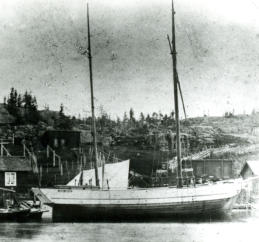
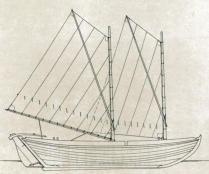

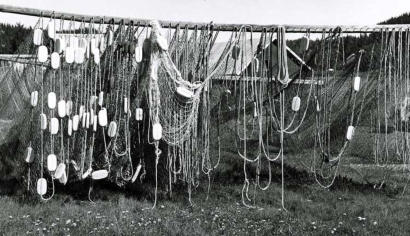

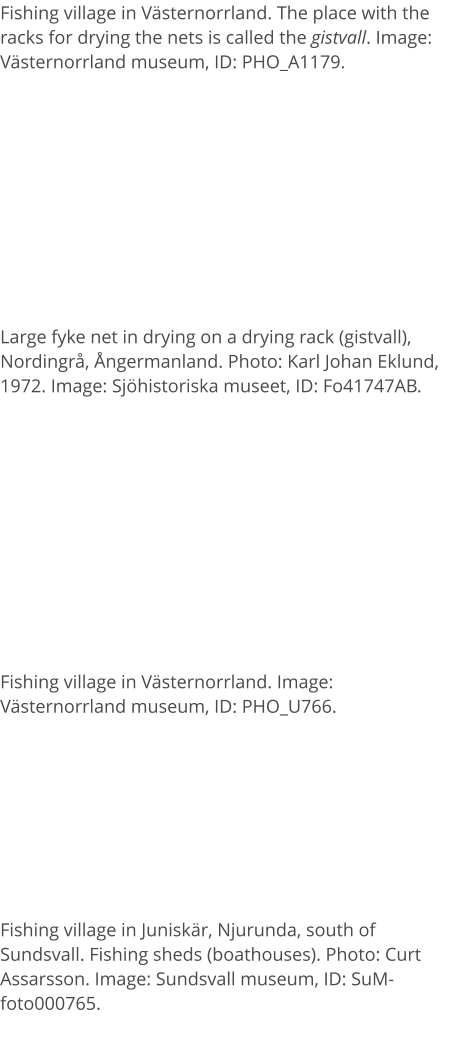
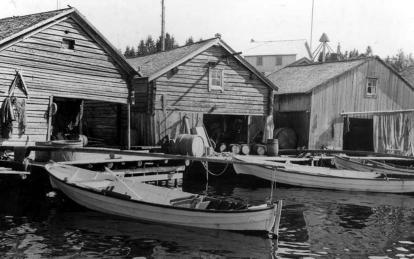
Who fished
On the Baltic coast, fishing was largely a sideline to
farming but also to various urban industries (urban
citizens). Fishermen used to be divided into the
categories of "professional fishermen" and "sideline
fishermen". The latter group is made up of those who
regularly fish for sale but whose main income is
derived from other occupations and of those who are
purely subsistence fishermen. However, there is no
clear dividing line between pure professional
fishermen and typical sideline fishermen.
A large number of farmers were regularly engaged in
fishing for sale to a greater or lesser extent, and it may
depend on the circumstances whether their main
source of income is fishing or farming.
More information on fishing and fishing methods








